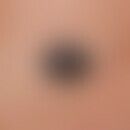Synonym(s)
DefinitionThis section has been translated automatically.
Non-invasive method for high-resolution in vivo imaging of tissue in real time, by using laser beams of defined wavelengths in reflected light, optical biopsy. The laser beam is focused on a plane within the skin, reflected at interfaces with a high refractive index and directed onto a detector. Due to an upstream pinhole aperture, only signals from a defined horizontal plane are used for imaging. Structures with a high reflectance are displayed brightly, such as keratins and melanin.
The method is suitable for differentiating benign and malignant superficial skin tumors of melanocytic and epithelial origin. Using horizontal sectioning with a section thickness of 5 µm, the tissue can be assessed at the cellular level down to a penetration depth of 250 µm.
The lateral image resolution is 0.5-1.0um at the cellular level. The axial resolution (slice thickness) is 3-5um.
General informationThis section has been translated automatically.
Even for an experienced histologist, horizontal imaging of tissue layers requires a complete rethinking of how structures are interpreted. As with sonographic techniques, laser light reflects at interfaces, light reflects at optical interfaces, and ultrasound reflects at acoustic interfaces. Strong light reflections occur in the skin by keratin, melanin, collagen, calcium and various foreign bodies. Other optically "homogeneous" structures, which are well represented with the usual staining methods in transmitted light microscopy, appear structureless or structurally weak in the laser scan.
The great advantage of the technique: the examination of the tissue is possible in real time. The result of the microscopic examination procedure is immediately available and can be discussed with the patient.
You might also be interested in
IndicationThis section has been translated automatically.
In dermatology, confocal laser microscopy is suitable for non-invasive diagnostics of skin structures close to the surface. Confocal laser microscopy is indicated for the diagnosis of near-surface melanocytic and epithelial tumors, such as malignant melanoma or basal cell carcinoma or actinic keratosis . A statement on the dignity of the changes is possible for experienced examiners. The preservation of the regular architecture of the epidermis, junctional zone, papillary body and the occurrence of atypical cells are assessed.
http://www.awmf.org/uploads/tx_szleitlinien/013-076l_S1_Konfokale_Lasermikroskopie_2011-07_01.pdf.
The detection and position of homogeneous nevus cell nests allows the differentiation of junctional nevus, compound nevus, dermal nevus. Characteristic nests with palisade structure in the dermis characterize the basal cell carcinoma. Actinic keratoses and squamous cell carcinomas are characterized by the removal of the regular epidermal architecture, which in confocal laser microscopy appears as honeycomb or cobblestone pattern.
In the case of superficial inflammatory skin diseases a diagnostic statement is difficult. Progress observations and quantification of therapy effects are however well possible.
In the diagnosis of discoloured finger and foot nails, fungal threads in the nail plate of an onychomycosis can be detected very well and in real time. Another indication is the detection of foreign bodies: for example, a suture granuloma can be easily distinguished from a local tumor recurrence.
The method is limited in deeper processes. They cannot be displayed due to the low penetration depth of the laser beam (about 250 µm).
Note(s)This section has been translated automatically.
Confocal laser microscopy can also be used ex vivo on freshly excised tissue "like a frozen section". This diagnostic approach can, with the appropriate experience of the examiner, gain in importance for the "microscopically controlled surgery" of skin tumors.
If monochromatic laser light and suitable filters are used, fluorescence can be used for imaging in addition to reflection. For this purpose, the skin areas to be examined must be stained with fluorescent dyes which are injected there.
Equipment
For confocal laser microscopy, devices with one or more lasers as light source are used, which can be used for both in vivo and ex vivo examination of the skin. Besides the light source at 830 nm, lasers at 445 nm, 488 nm, 658 nm and 785 nm are used for fluorescence and reflection diagnostics.
commercially available are, for example, Vivascope 1500, which can scan an area of 8 x 8 mm at various slice depths, and Vivascope 3000, a hand-held unit that covers an area of 0.75 x 0.75 mm and is also suitable for more difficult to access areas such as the nose, ear or eye.
LiteratureThis section has been translated automatically.
- Astner S et al (2010) Preliminary evaluation of benign vascular lesions using in vivo reflectance confocal microscopy. Dermatol Surg 36:1099-1110
- Bahadoran P (2015) Reflectance confocal microscopy: a new key for assessing the role of Demodex in rosacea? Br J Dermatol 173: 8-9
- Benati E et al (2015) Melanoma and naevi with globular pattern: confocal microscopy as an aid for diagnostic differentiation. Br J Dermatol doi: 10.1111/bjd.14049.
- Calzavara-Pinton Pet al. (2008) Reflectance confocal microscopy for in vivo skin imaging. Photochem Photobiol 84:1421-1430.
- Chung VQ et al (2004) Use of ex vivo confocal scanning laser microscopy during Mohs surgery for nonmelanoma skin cancers. Dermatol Surg 30:1470-1478
- Cinotti E et al (2015) Sensitivity of handheld reflectance confocal microscopy for the diagnosis of basal cell carcinoma: A series of 344 histologically proven lesions. J Am Acad Dermatol 73:319-320
- Longo C et al (2015) Ex vivo fluorescence confocal microscopy in conjunction with Mohs micrographic surgery for cutaneous squamous cell carcinoma. J Am Acad Dermatol 73: 321-322.
- Reggiani C et al (2015) Update on non-invasive imaging techniques in early diagnosis of non-melanoma skin cancer. G Ital Dermatol Venereol 50: 393-405.
- Ulrich M (2015) Confocal laser scanning microscopy Hautarzt 66:504-510.
- Welzel J et al (2011) AWMF guideline "Confocal laser microscopy in dermatology" AWMF-online.
- https://derma.de/fileadmin/derma/1_derma.de_WebRoot/Aerzte/Leitlinien/013-076l_S1_Konfokale_Lasermikroskopie_der Haut_2017-08.pdf.



























